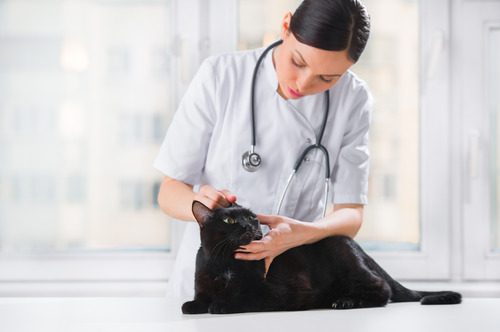If your cat has been scratching their ears more than usual or shaking their head often, it may be more than just an itch. A cat ear infection can cause significant discomfort and, if left untreated, may lead to long-term issues. These infections aren’t as common in cats as they are in dogs, which can make the signs harder to recognize at first. In this blog, we’ll explore the potential causes, common symptoms, and how veterinary treatment can help your cat feel better—fast. If you notice any signs of a cat ear infection, contact Fetch Specialty & Emergency Veterinary Centers right away to schedule an evaluation.

What Causes a Cat Ear Infection?
Cat ear infections typically result from inflammation in the outer ear canal, but they can also affect the middle or inner ear. Understanding the root cause can help guide proper treatment.
Common Causes of Outer Ear Infections
- Ear Mites: These tiny parasites are one of the most frequent causes of ear problems in cats, especially kittens or outdoor cats.
- Allergies: Food or environmental allergens can trigger inflammation and lead to secondary infections.
- Moisture Buildup: Water trapped in the ear—especially after a bath—can create a humid environment that encourages bacterial or yeast growth.
- Foreign Objects: Grass seeds, dirt, or other debris lodged in the ear canal may irritate the skin and lead to infection.
Deeper Ear Infections
Middle and inner ear infections may result from untreated outer ear infections that spread. These can cause more severe symptoms and often require advanced imaging or referral to a specialty hospital like Fetch for proper diagnosis and care.
Recognizing the Symptoms of a Cat Ear Infection
The signs of a cat ear infection can be subtle at first. However, when symptoms become more noticeable, they often point to significant discomfort.
Behavioral and Physical Signs
- Frequent head shaking or tilting
- Persistent scratching at one or both ears
- Redness or swelling inside the ear flap
- Dark, waxy, or foul-smelling discharge
- Sensitivity to touch around the ears or head
- Scabs or crusting at the base of the ear
In more advanced cases, especially if the inner ear is involved, you may also notice issues with balance, walking in circles, or abnormal eye movements.
How Vets Diagnose a Cat Ear Infection
Veterinarians follow a step-by-step approach to diagnosing a cat ear infection and identifying what’s causing it.
Physical Examination
A thorough ear exam is the first step. Your vet will look for redness, discharge, swelling, or foreign material in the ear canal. An otoscope may be used to examine deeper into the canal.
Microscopic Evaluation
A sample of the discharge is typically collected and examined under a microscope. This helps determine if bacteria, yeast, or mites are present and guides treatment decisions.
Advanced Imaging or Testing
If the ear infection is chronic or doesn’t improve with treatment, your vet may recommend imaging such as X-rays or a CT scan. These tests can reveal issues in the middle or inner ear, including tumors, polyps, or structural abnormalities.
Veterinary Treatment Options for Cat Ear Infections
Treatment depends on the underlying cause, severity of the infection, and whether it’s limited to the outer ear or extends deeper.
Cleaning the Ear
Before treatment can begin, the ear canal may need to be gently cleaned to remove debris and discharge. This step is best done in a veterinary setting to avoid injury or pushing material deeper into the canal.
Medication
- Topical Treatments: These may include anti-inflammatory, antifungal, or antibiotic ointments or drops.
- Oral Medications: In more severe cases, your vet may prescribe oral antibiotics, antifungals, or corticosteroids.
- Parasite Control: If ear mites are found, medications specifically targeting parasites will be used. Your vet may also recommend treating all pets in the household.
Follow-Up Visits
It’s important to complete the entire course of prescribed treatment and return for follow-up visits. Your vet will check the ear’s progress and determine whether additional treatment is needed.
Potential Complications If Left Untreated
A cat ear infection may seem minor at first, but without timely care, it can lead to more serious problems.
Chronic Pain and Irritation
Untreated infections can cause lasting inflammation, pain, and damage to the ear canal or eardrum, which may reduce hearing over time.
Deeper Infections
When infections spread to the middle or inner ear, your cat may suffer from balance problems, facial nerve paralysis, or more widespread illness that requires urgent or advanced treatment.
Risk of Recurrence
Recurring ear infections may indicate an underlying issue, such as allergies, ear canal tumors, or immune dysfunction. Managing the root cause is the key to long-term resolution.
Why Timely Veterinary Care Matters
Prompt treatment for a cat ear infection can relieve discomfort, prevent complications, and help your cat get back to their normal routine. If you notice changes in your cat’s behavior or see signs of irritation around the ears, contact Fetch Specialty & Emergency Veterinary Centers. Our experienced team is equipped to diagnose and treat ear infections at every level—whether it’s a routine outer ear infection or something more complex that requires specialty care. We’re here to support your cat’s health with the same urgency and dedication we’d want for our own pets. Give us a call to schedule your visit.
About Us
Fetch Specialty & Emergency Veterinary Centers is a family-owned practice providing elevated specialty care, emergency medicine, and critical care in three convenient locations throughout Florida and South Carolina. Our board-certified veterinarians and highly skilled support staff all share a deep appreciation for pets, people, and the human-animal bond. We recognize how much you love your pet as a part of your family, and that’s why we love what we do!

